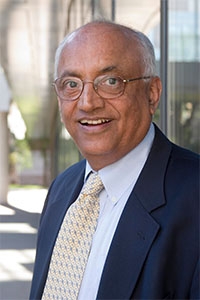Venkatesh Narayanamurti
Venkatesh “Venky” Narayanamurti was born in Bangalore, India in 1939. He earned his bachelor's and master's degrees in physics (in 1958 and 1960, respectively) from St. Stephen’s College, Delhi University, one of India's leading institutions in the liberal arts and the sciences.
While there, he was a debater, President of the College Union, and a track and field star—the only physics major on the team. Narayanamurti earned his Ph.D. in physics from Cornell University in 1965.
He is credited with developing the field of phonon optics: the manipulation of monoenergetic acoustic beams at terahertz frequencies and is currently active in the field of semiconductor nanostructures.
Narayanamurti has served on numerous national and international advisory committees and is an elected member of the National Academy of Engineering, the Royal Swedish Academy of Engineering Sciences, and the American Academy of Arts and Sciences. He is a fellow of the American Physical Society; the American Association for the Advancement of Science; the Institute of Electrical and Electronics Engineers; and the Indian Academy of Sciences.
He has served on numerous advisory boards of the federal government, professional societies, national laboratories, and industry. In addition to serving in administrative and research roles, Narayanamurti lectures widely on solid state, computer and communication technologies, and on the management of Science, Technology and Public Policy.
He is married and is the father of three children. His recreational loves are running, squash, and his home on Cape Cod, where he relaxes or finds “shanti” by reading, catching up on research, and listening to music.
Life in the Lab
From 1968 to 1987, Narayanamurti worked at the famed AT&T Bell Laboratories, where he became head of the Semiconductor Electronics Research Department in 1976 and served as Director of the Solid State Electronics Research Laboratory from 1981 to 1987.
In this position, Narayanamurti had primary responsibility in initiating new programs at the interface of science and technology relevant to the information age. The entrepreneurial spirit and boundary-free environment of Bell had a profound influence on him. Moreover, his passion at Bell became recruiting talented people, some of whom went on to win Nobel Prizes.
Narayanamurti, on assignment from Bell Labs, then became vice president of research and exploratory technology at Sandia National Laboratories, serving in that role from 1987 to 1992. He oversaw an annual budget of $225 million and a staff of 1100 employees spanning seven Directorates and 25 Departments.
Sand, Surf, and Engineering
In 1992 Venky made the move from industrial/government settings to academia, becoming Richard A. Auhll Professor and dean of the College of Engineering at the University of California, Santa Barbara (UCSB), where he served from 1992 to 1998.
At UCSB he recruited a large number of faculty, fostered interdisciplinary research, and nurtured entrepreneurship and collaborations with industry. His name lives on at UCSB in the form of the “Venky Narayanamurti Entrepreneurial Leadership Award" (nicknamed the “Venky”). In addition, the first endowed chair in computer science was also named for him by Karl and Pamela Lopker and the Lopker Family Foundation and an anonymous donor.
In the OC Register, columnist Gary Collins referenced his accomplishments in a piece about engineering at the University of California, Irvine. His advice: “UCI should follow the cue of U.C. Santa Barbara, whose engineering program soared under Dean Venkatesh Narayanamurti, a quiet visionary who called attention to the school, not to himself.”
Crimson Days
Upon his arrival at Harvard in 1998 he said in an interview with Harvard Magazine: “the goal is to build a small but absolutely preeminent school of engineering in a liberal-arts environment.”
He served as dean of the Harvard School of Engineering and Applied Sciences (SEAS) for 10 years, directing the renewal and expansion of the former division and its transition to a School.
Narayanamurti guided remarkable gains in the recruitment of junior and senior faculty. The SEAS faculty is now 50 percent larger than when he was named dean in 1998, with faculty productivity and satisfaction fostered through new research funding; mentoring for junior colleagues; and staff support to facilitate grants and contracts, communications, information technology, and development.
Sponsored research has grown 60 percent over the 10 years. He has helped to raise nearly $100M in donations, spurred on by a $45 million Challenge Fund for Harvard Engineering and Applied Sciences that raised 10 new professorships and 10 Dean’s Innovation Funds.
Narayanamurti was an early champion of interdisciplinary initiatives and collaboration. In 10 years at Harvard, he has reached out to colleagues in the FAS, Harvard Medical School, Harvard Business School, and the Harvard School of Public Health to establish new partnerships and build new relationships that span traditional academic boundaries.
In 2003, he was appointed the first dean of physical sciences at the FAS, a position he held three years while simultaneously serving as dean of the then-Division of Engineering and Applied Sciences.
Seeing students at the heart of the transformation at SEAS, Narayanamurti has made a priority of enhancing student recruitment and to enrich the curriculum over the past decade. Under his leadership, SEAS faculty have developed creative and innovative programs to attract students, including new courses of study in computer science, electrical engineering, and bioengineering at the graduate and undergraduate levels.
During his tenure, SEAS also has seen a dramatic increase in the number of applications from graduate students, making SEAS one of the most selective programs in the country.
A true Harvard loyalist, while Narayanamurti originally announced his decision to return to teaching and research in 2005, he agreed to stay on as dean to oversee the SEAS transition and launch of the new School.
President Drew Faust said upon the Launch of the Harvard School of Engineering and Applied Sciences, September 20, 2007: “And then, of course, there’s Venky – the one and only Venky – the North Star of our engineering galaxy whose foresight, determination, and energy we have to thank for the milestone that brings us together today.”
